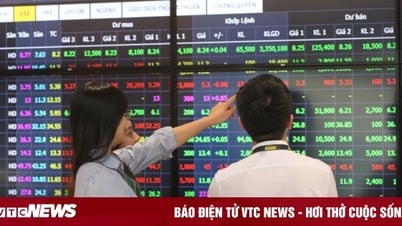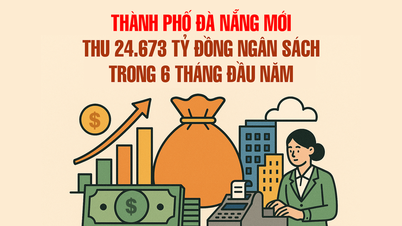
In 2024, Vietnam's exports to the US will account for about 29.5% of total export turnover with a value of 119.5 billion USD. Key export items include computers, electronic products, components, machinery, equipment, textiles and wood... (Photo: Vietnam+)
On July 5, at the regular press conference to announce socio -economic statistics, Mr. Le Trung Hieu, Deputy Director of the General Statistics Office, shared some analytical assessments on the impact of reciprocal taxes from the US on GDP growth, based on different scenarios.
The assessment of these scenarios is intended to provide data for macroeconomic management and help businesses have a clearer view of the challenges and opportunities in the coming time.
Impact on key industries
To understand the impact of tariff scenarios, it is necessary to first look at the overall picture of Vietnam-US bilateral trade relations. The US is currently Vietnam's largest export market, playing a key role in promoting economic growth and creating millions of jobs.
In 2024, Vietnam's exports to the US will account for about 29.5% of total export turnover with a value of 119.5 billion USD. Main export items include computers, electronic products, components, machinery, equipment, textiles and wood...
In addition, Vietnam is also the 8th largest trading partner of the US, accounting for about 4% of total US exports. Vietnam's trade surplus with the US is 104.4 billion USD. The proportion of Vietnam's exports to the US has been determined to increase in recent years.
According to the 2024 Foreign Trade Barriers Report of the Office of the United States Trade Representative (USTR), the average Most Favored Nation (MFN) tariff rate that the US is applying to Vietnamese goods is 9.4%.
However, this tax rate is clearly differentiated when agricultural goods are subject to a high tax rate of 17.1% and non-agricultural goods have an average tax rate of 8.1%. This is the basic tax rate for consideration and any changes in tax policy from the US side will be calculated based on this average rate of 9.4%.

Three key product groups are dominating, including computers, electronic products and components reaching 23.2 billion USD, accounting for 19.4% of total turnover. Machinery, equipment, tools and spare parts reached 22 billion USD, accounting for 18.5%. Textiles and garments reached 16.2 billion USD, accounting for 13.5%. (Photo: Vietnam+)
According to data from the General Department of Customs in 2024, Vietnam had 15 items with export value of over 1 billion USD, showing the diversity and depth in the structure of Vietnam's exports.
Of which, three key product groups are taking up the overwhelming proportion, including computers, electronic products and components reaching 23.2 billion USD, accounting for 19.4% of total turnover. Machinery, equipment, tools and spare parts reached 22 billion USD, accounting for 18.5%. Textiles and garments reached 16.2 billion USD, accounting for 13.5%.
Thus, these three groups of goods account for more than half of the total export value to the US. Therefore, these will be the areas that will be affected if there is any change in tariff policy.
Three scenarios with implications
On that basis, the General Statistics Office proposed the first scenario with an average reciprocal tax rate of 10% applied to all Vietnamese export goods, the average tax increase impact would be only 0.6 percentage points and lead to a corresponding increase in the price of Vietnamese goods in the US market.
According to the Census Bureau's calculations, the tax increase would increase the final retail price to American consumers by about 0.5%. In economics, when prices go up, quantity demanded falls. The magnitude of the fall depends on an important metric called the "price elasticity of demand." The Census Bureau's analysis considers two assumptions about this elasticity.
Assuming the elasticity coefficient is 1 (ie if the price increases by 1%, the demand decreases by exactly 1%), Mr. Hieu said that the demand for Vietnamese goods will decrease by about 0.5%, equivalent to a 0.5% decrease in export value to the US market.
In addition, assuming an elasticity coefficient of 1.2 (in case consumers are more sensitive to prices), Mr. Hieu said that demand will decrease by about 0.6%, thereby estimating that GDP will decrease by about 0.05 percentage points.
The second scenario, with the US deciding to impose an average tax rate of 15%. According to Mr. Understand, when the average reciprocal tax rate is raised to 15%, the average tax increase compared to the current level will be 5.6 percentage points (from 9.4% to 15%).

With a 20% reciprocal tax rate, export turnover will decrease by about 9-10% and the final impact will be to reduce GDP by about 0.8 percentage points. (Photo: Vietnam+)
In the third scenario, with a 20% reciprocal tax rate, retail prices in the US market are forecast to increase by about 9.7%.
Mr. Understand that the impact assessment scenarios are based on conditions, assuming the elasticity coefficient is in the range of 1-1.2%. Finally, it is assumed that there is no impact on increasing or expanding export markets and promoting existing free trade agreements (FTAs).
Source: https://vtcnews.vn/3-kich-ban-du-bao-thue-doi-ung-co-the-tac-dong-den-tang-truong-ar952872.html























































































![[OCOP REVIEW] Bay Quyen sticky rice cake: A hometown specialty that has reached new heights thanks to its brand reputation](https://vphoto.vietnam.vn/thumb/402x226/vietnam/resource/IMAGE/2025/7/3/1a7e35c028bf46199ee1ec6b3ba0069e)










Comment (0)